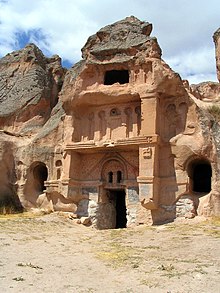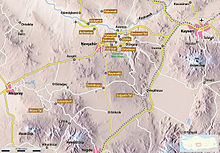

Rock-cut architecture in Cappadocia in Central Turkey includes living and work spaces as well as sacred buildings like churches and monasteries, that were carved out of the soft tuff landscape.
Mount Erciyes south of Kayseri, Mount Hasan southeast of Aksaray, Mount Melendiz in Niğde, and some smaller volcanoes covered the region of Cappadocia with a layer of tuff stone over the course of a twenty million year period ending in prehistoric times, after which erosion created the well-known rock formations of the region.[1] The process is a special form of the rill erosion which affects much of Turkey, in which the solidity of the volcanic tuff and ignimbrite creates particularly deep and steep-sided streams, which create tower-like shapes were they meet at right angles.[2] Since this soft stone is comparatively easy to work, people were probably carving it into dugouts by the early Bronze Age. In the course of time, this progressed to living complexes, monasteries, and whole underground cities. Since 1985, the 'rock sites of Cappadocia' have been a UNESCO World Heritage Site.[3]
- ^ Wolfgang Dorn: Türkei – Zentralanatolien: zwischen Phrygien, Ankara und Kappadokien. DuMont, 2006, ISBN 3770166167, p. 15 bei GoogleBooks
- ^ Wolf-Dieter Hütteroth/Volker Höhfeld: Türkei. Wissenschaftliche Buchgesellschaft Darmstadt 2002, p. 50 ISBN 3534137124
- ^ Entry in the list of the UNESCO World Heritage Sites.